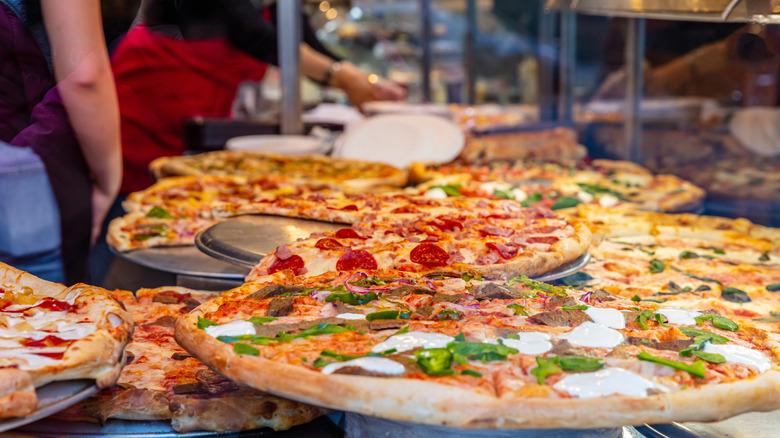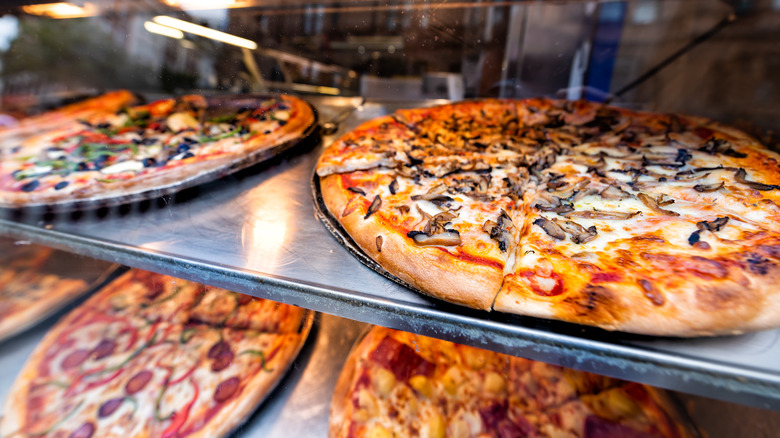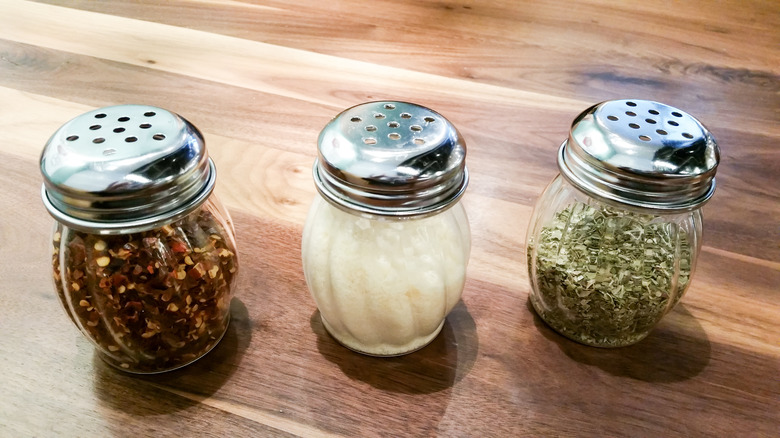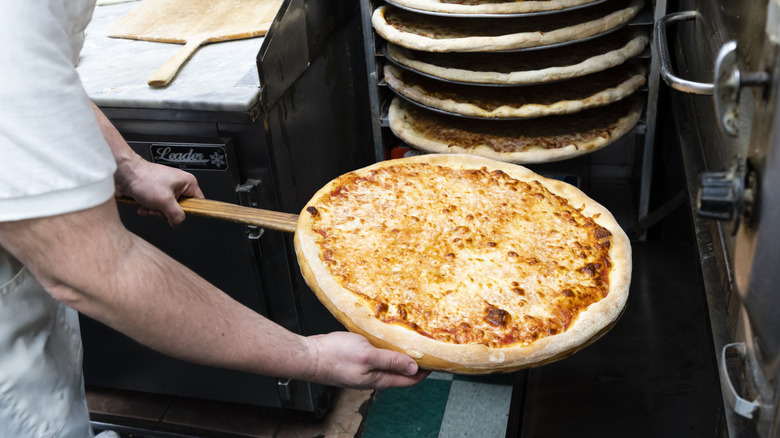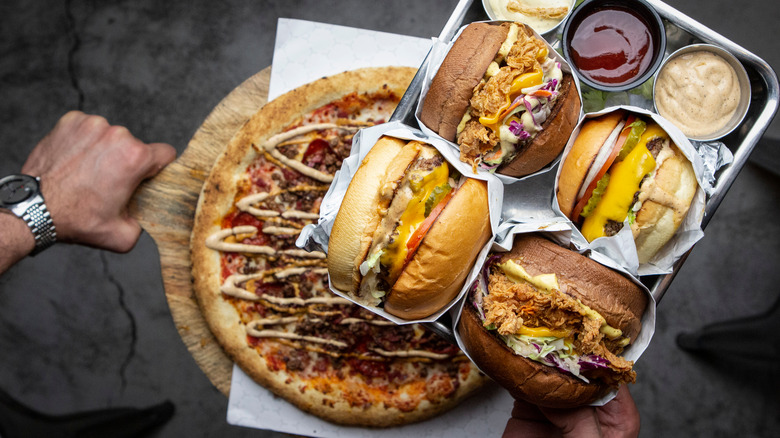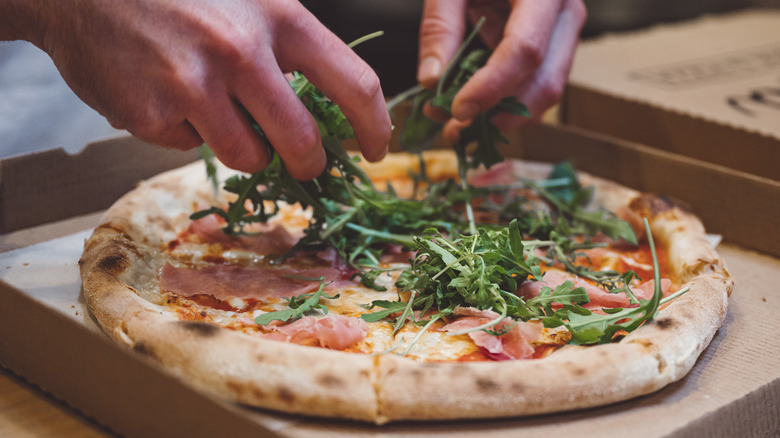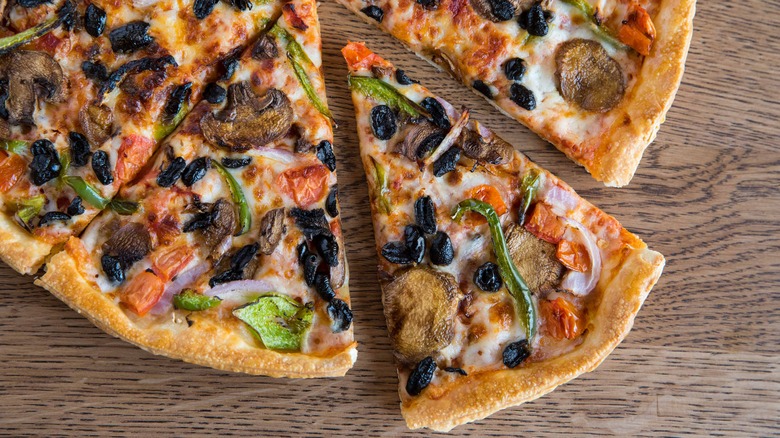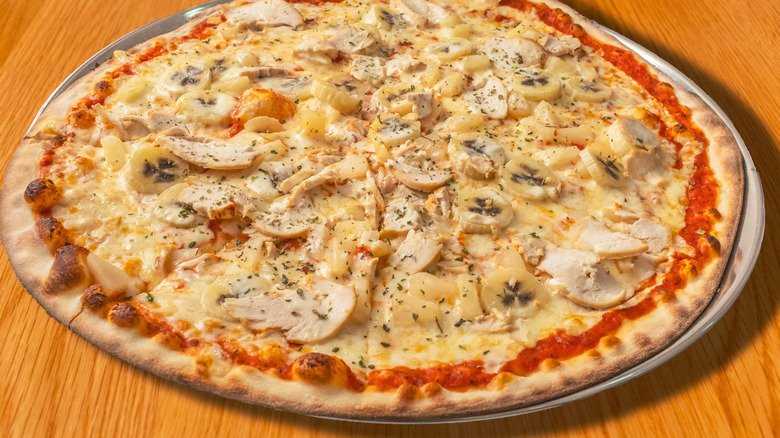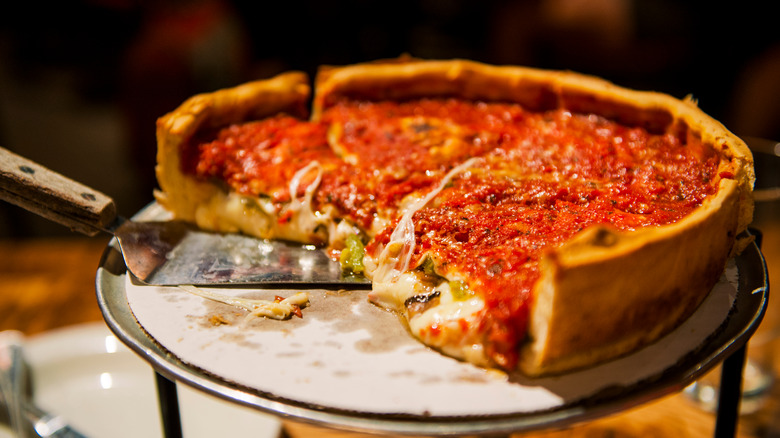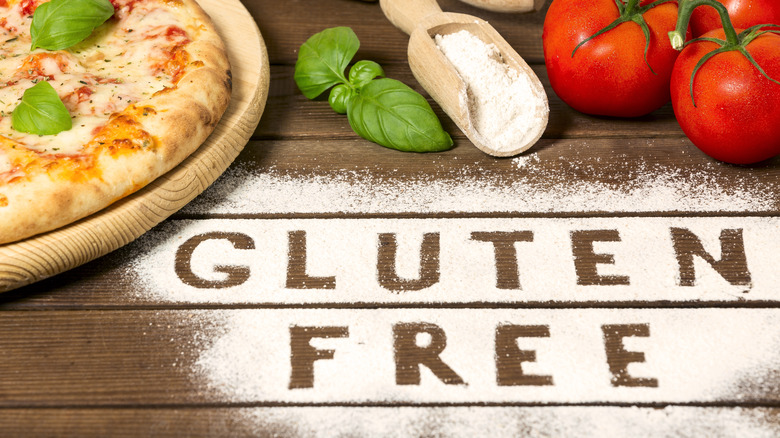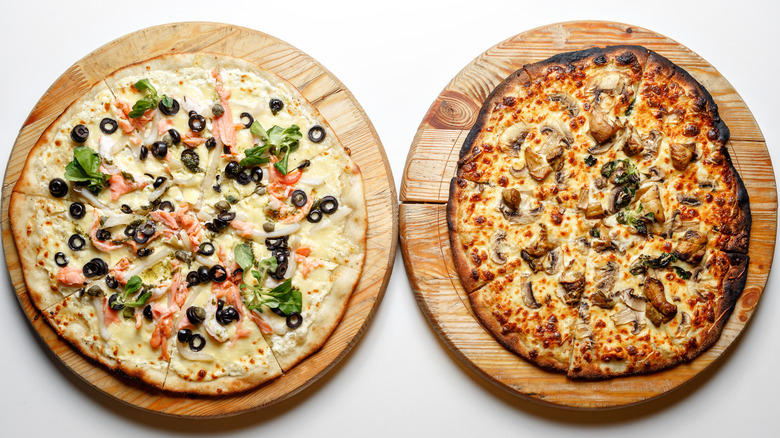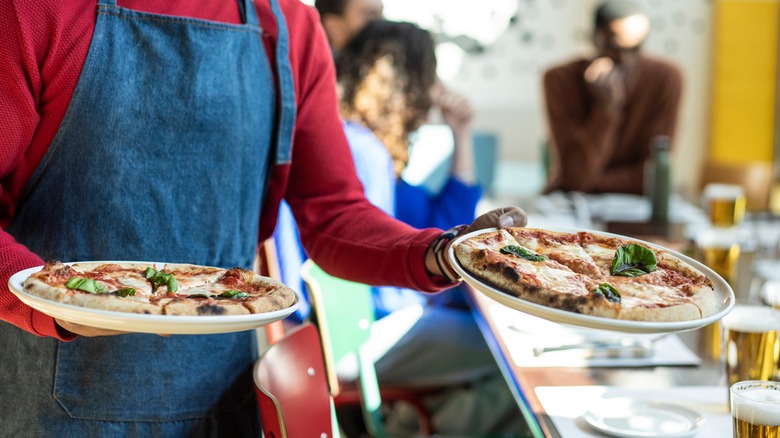13 Red Flags At A Pizza Shop That Could Indicate More Than A Bad Slice
There might not be anything in this world better than a fresh, piping-hot pizza. Perhaps that's because the crispy, cheesy, saucy staple is comfort food for millions around the globe. From Naples to Detroit, from deep dish to thin crust, from meat lovers to Margherita, there's a pizza style out there for pretty much everyone.
The saying goes that even when pizza is bad, it's still pretty good, but we don't necessarily subscribe to that idea. Just because pizza is a universal favorite doesn't mean it's going to be good just anywhere. In fact, if you're headed out for 'za — whether at a high-end artisanal pizzeria or a simple slice shop — there are some red flags you should keep in mind to ensure you pick a place that will provide the best possible experience. With something as familiar as pizza, the difference is all in the details, and not every pizza place is created equal. Here's what you should look out for.
The smell doesn't draw you in
Pizza is a sensory experience, and before you ever take a bite, the first thing you're going to do is smell it. That's not by choice, either — pizza has a distinct scent that you can usually catch from a ways away. And there's nothing quite like walking past or into your local pizzeria and catching a whiff of hot cheese, tomato sauce, and dough wafting from its ovens. It's a warm, comforting aroma that fully envelops you and even sticks to your clothes — and it's also a sign that whatever's cooking inside is probably pretty good.
Our senses of taste and smell are directly connected. In fact, it's commonly argued (though not certain) that up to 95% of our taste is actually derived from our sense of smell, notes Flavour. And even if that's not scientifically proven, ask yourself this: How much more excited do you become when a restaurant you're about to dine in smells really, really good? If the pizza place you're going to doesn't have waves of that welcoming scent hitting your nose before you place your order, you might be in for a subpar slice.
Pizzas on display don't look very good
Smell is certainly important when it comes to pizza, but sight helps, too. Generally speaking, we don't like judging a book by its cover, but when you walk into a slice shop and check out the display case full of pizzas, it's okay to trust your eyes. Do the pizzas you see look tasty? If not, you shouldn't expect yours to, either.
What exactly does an unappetizing pizza look like, though? Personal preference comes into play here, but a few things that can tip you off are undercooked crust, sloppily applied toppings, or anything that doesn't look particularly fresh (more on that in a moment). If the pizza restaurant you're at doesn't have single-slice order pies on display, see if you can catch a quick look at the pizzas already sitting on customers' tables before you walk in. If you're not familiar with the place, that peek might save you from sitting down for a disappointing pie.
Display pies are whole
First impressions are everything, and a pizza place's display case is, in many ways, just that. It serves as an introduction, the first chance you have to see exactly what is on offer and, as we mentioned, judge whether or not this pizza is worth consuming. But if you can't determine based on looks alone, turn to fractions — and in this case, more might actually mean less (appetizing, that is).
The logic here might seem odd, but it's fairly straightforward: If the pizza pies in the window are full, there's a decent chance they've been sitting there for some time. God knows how many prior patrons have walked in and either ignored said pizzas or found them unappealing and opted for something else. Chances are you should, too. There are caveats, of course — you might happen to walk into said pizza shop after they first set out pies for display or replaced a recently finished pizza with a fresh new one. In either case, you'll be able to tell using your other senses. Chicken bacon ranch might be your favorite, but if it's 4 p.m. and no one's touched the pie that's sat there all through the lunch rush, it probably isn't the one.
Easily addable toppings are nowhere to be found
Pizza is pretty much perfect on its own, regardless of what style or toppings tickle your fancy. But that doesn't mean you can't turn things up with a little dash of ingredients that take your already good slice to the next level.
Any slice shop worth its weight in tomato sauce should have at least two toppings available within easy reach: grated Parmesan and red pepper flakes. More cheese might seem excessive, especially if you're adding it to a plain slice, but the way that grated, salty Parmesan melts into the hot mozzarella is the stuff dreams are made of. Red pepper flakes also bring some much-loved heat into the mixture. We also love a sprinkle of Italian seasoning (namely oregano) or garlic powder on our plain slices, though we won't necessarily hold it against a pizza restaurant if those aren't available, as too much of either will absolutely destroy your slice (and your taste buds).
They don't offer to (or automatically) heat up your slice
We believe there's a place in this world for cold pizza. Nothing can truly replicate the sweet, slightly hungover satisfaction of polishing off the leftover pie sitting on your table from the night before. It's the kind of resourceful behavior that cuts down on food waste and keeps our world turning.
When you're hitting up a pizza shop, though, cold pizza doesn't deserve a seat at the table. You're there for the full experience, and even if it's not fresh this minute, it can still be hot. It should be standard practice to either automatically heat up a person's individually ordered slices or, at the very least, ask them if they'd like the slices heated up. It might seem like a small detail, but since pizza is best enjoyed hot, a place that does this is taking its customers into account and showing it cares about presenting the best possible version of its product.
If you don't want your pizza warm (or worry that the place might overheat it and make it too hot), you can always request to take your slices as is or decline their offer to heat it up. But if you don't see them take your slice to the oven or hear them pop the heating question, they might as well stick a little red flag into the lukewarm dough before handing you the slice.
The menu is focused on too many things besides pizza
To be clear, we're not talking about mozzarella sticks, penne vodka, or other common dishes you might find on your average pizza menu. The very genre of "pizza place" casts a fairly wide net that includes a fair number of fried appetizers, pasta dishes, and a loaded sandwich or three. But once it seems like the menu is drifting into odd locations — say, an entire section dedicated to fried chicken — it could be that the pizza shop you're ordering from is focused on the wrong things.
Making and serving delicious pizza is the name of the game. Sure, we've been swayed to order from one place over another based on garlic knot superiority, but there's a baseline of pizza quality that must be met. There's something to be said for versatility, but too much of it can tank a pizza menu. If it feels too scattered or is simply not based around the star of the show, we're likely looking elsewhere.
Ingredients, particularly produce, aren't fresh or local
You can't make great food without great ingredients. And since pizza is such a simple dish with relatively few ingredients, the quality of those ingredients is paramount. Crappy canned tomatoes and poor pepperoni simply won't cut it here. When a pizza restaurant cares about what it puts in and on its pizza, you'll be able to tell the difference far more easily than you think. If it's a higher-end pizza restaurant, don't be afraid to run through the menu online or check the place's website to see if it's partnered with local growers and producers.
That said, not every pizza shop is going to list where it got its ingredients from, and that's okay. We're not about to string up your local slice shop if it's not sourcing arugula from a nearby family farm. But the produce that goes on its pizzas should look and taste as fresh as can be. The same is true of meats that go on pizza, too — the better it is, the better the final product will turn out.
Veggie pies/slices are overloaded with toppings
Speaking of produce, we're of the mind that veggie pizzas are criminally underrated. You can toss olives or mushrooms on a pie and call it a day, but why stop there? Fresh seasonal greens are always a treat, as well as alliums like roasted garlic or spring onions. A good pizza restaurant will not just use fresh produce but understand exactly what ingredients play well off each other to make a stunning pizza.
The key, though, is not doing too much. While we love veggie pies, what we don't love are the ones that sink beneath the weight of the toppings. You've surely seen this type of pizza before — flooded with dry broccoli florets, bell peppers, shriveled zucchini, onions, and every other vegetable you can think of. You can hardly see any cheese or sauce, and the only evidence of crust are the bits peeking out at the top of each slice. Something about these pizzas never seems fresh, and they're a sign that the shop in question views its veggies pies as the opportunity to toss as much produce on top of a pizza as possible. You deserve better.
Too many gimmicky pies
Variety is the spice of life, and the same is true of pizza. Pretty much any pizza restaurant will have its specialties beyond plain cheese, and we're all for trying something a little surprising. It's easy to take it too far, though. What might've started as a simple pizza replacing regular tomato sauce with vodka sauce can quickly turn into a pie covered in baked ziti and dollops of ricotta. And while that sounds pretty good, it's a slippery slope between decadent, stacked pizzas and flat-out disasters.
Now, is there anything inherently wrong with a Caesar salad or cheeseburger pizza? No. In fact, if they're done well, they can be a tasty treat and even worthy of a quick Instagram post. But if a pizza place seems a little bit too focused on these types of pies — like, say, has them lining a display case — it's fair to assume full attention isn't being paid to the regular pizzas that make or break any good restaurant. We won't steer clear of a fun gimmick, but too many of them are a clear red flag.
The shop has more than one or two styles of pizza available
In some cities and regions, specific styles of pizza are a way of life. Someone who has spent their life dedicated to mastering Neapolitan pizza might look down on Roman-style pizza, just as a New Havener scoffs at anyone who claims the best pizza in the U.S. is made somewhere other than on Wooster Street (we're partial to Sally's over Frank Pepe, ourselves).
It's all about preference, of course, but you should be wary of any pizza place that offers more than a couple of different styles of pizza. Having a designated Sicilian pie or two is perfectly reasonable, but if a pizza shop offers New York-style, Chicago deep dish, Detroit-style square cut, and thin crust, odds are that one (or more) of those pizzas are lacking. Different styles require different doughs, cheeses, sauces, and even cooking styles. What works best in a wood-fired oven might not turn out nearly as good in convection. Perfecting one type of pizza is hard enough. Once again, if it seems like a pizza joint might be doing too much, it probably is.
Steps aren't taken to accommodate dietary restrictions
Delicious though it may be, pizza is full of dietary landmines, including excessive amounts of dairy, gluten, and meat in some cases. Not every slice shop is going to offer gluten-free or vegan options, and we get that. But if you're headed out for a family dinner and have one or more people in your party with dietary restrictions, it's a bummer to cross off your favorite pizza place because they don't have any offerings to accommodate them.
It doesn't stop with what's on the menu, though — protocol should be in place to ensure pizzas listed as gluten-free or vegan don't come in contact with anything that might compromise their dietary designation. That includes using separate pans for cooking and serving as well as pizza cutters for slicing. It's a simple way for a pizza place to show it actively cares about patrons with dietary restrictions and isn't listing those options on the menu just for show.
Each pizza looks exactly the same — especially the crust
Consistency is one of the ultimate goals in the restaurant industry. You want to produce a great product every time to keep customers coming back for more. But there's a difference between consistency and monotony, especially when it comes to pizza. While you want your pies to look and taste consistently good, you don't necessarily want them to look the same every single time.
Slight differences in the crust, from burn marks and bubbles to overall shape, are a sign that the pizzas are being hand-crafted by pizzaiolos and kitchen staff that care. Think of each pizza as a separate work of art — you wouldn't want the same exact thing as the table next to yours, and vice versa. Placing cheese in identical patterns or basil leaves in the same spots on each pie is downright boring. While they should be roughly the same size, an identical appearance implies an automated process that you can regularly find at fast-food pizza chains. We've got nothing against the Domino's and Pizza Huts of the world, but unless you're partial to the robotic presentation of a pizza chain, a little differentiation is what you want to see.
Service and/or cleanliness don't seem important
You could argue we saved the most obvious red flag for last, but cleanliness and service are far too important to leave unmentioned. This applies to any kind of restaurant, of course. Whether you're eating a slice of pizza at a standing table, sitting down in a steakhouse, or cozying up to the bar for a burger, no one wants to eat in a dirty or unkempt restaurant. Likewise, no one wants to be served by anyone who's rude or doesn't appear to care.
At a pizza restaurant, these signs are obvious — napkins and other garbage is strewn about, surfaces are left unwiped, and kitchen staff are working without hats or hair ties. Slice shops are known to get busy, and there's not always a line or ordering system in place, but attentive staff will always make sure you're taken care of. In a sit-down pizza place, the same red flags as any other restaurant come into play — are the staff attentive and polite? Are requested items accounted for and addressed in a relatively timely fashion? Then you're good to go. If not, consider finding another place to satisfy your pizza cravings next time around.


